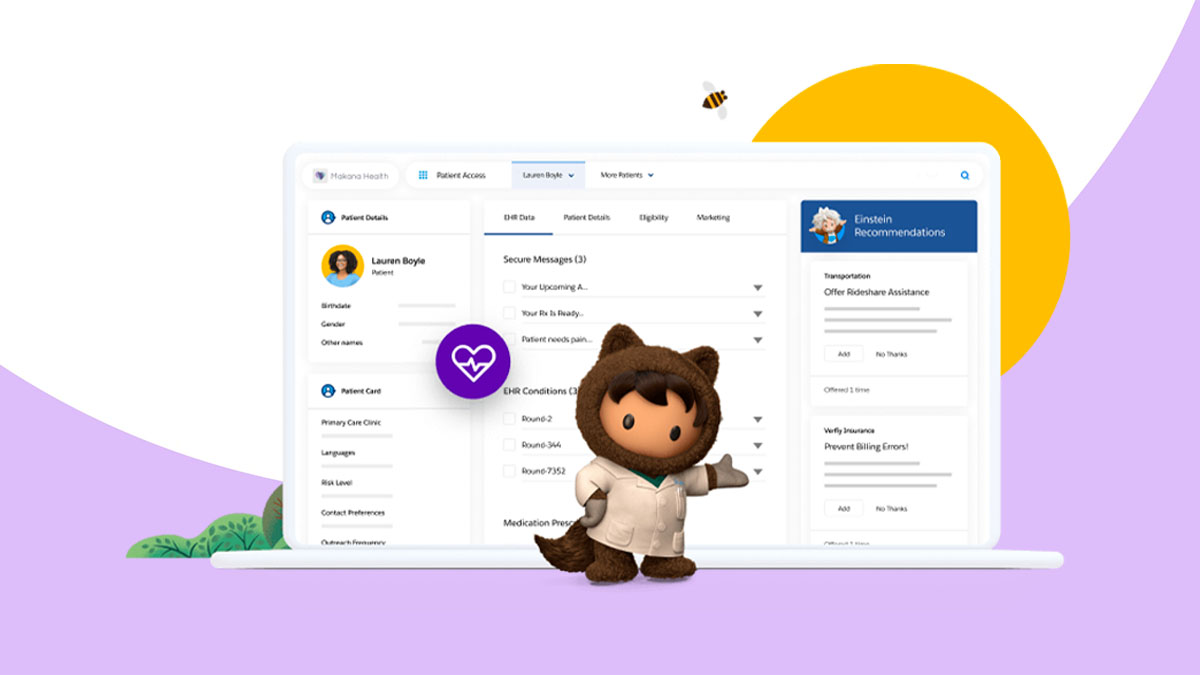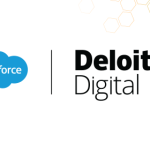Patient-centred healthcare is the future. Providers who focus on building strong relationships and a connected patient experience aren’t just reporting better outcomes in terms of health, they’re also better at controlling costs and managing their physician network.
With concerns around patient data security and protecting PII (Personal Identifiable Information), some providers are hesitant to take the necessary steps into cloud technology. Salesforce knows the importance of trust and works hard to protect all information. With this in mind, let’s learn more about Salesforce Health Cloud.
A single, secure platform that enables healthcare organisations to deliver personalised care at a scale that’s intelligent, patient-focused, and modern. Let’s take a look at five ways healthcare organisations such as hospitals use Salesforce to revolutionise patient care.
Health Cloud
See how Health Cloud can improve outcomes and lower costs for your Industry.

1. Healthcare at home
There’s no place like home, and that’s particularly relevant when it comes to managing our health. While the pandemic changed public perceptions of healthcare settings – particularly among the elderly and clinically vulnerable – a 2018 ARP survey revealed that 75% of adults aged over 50 want more clinical support at home.
Traditionally, the only way to access trusted, reliable medical advice was to visit a doctor, but things have changed. Patients are much more likely to Google their symptoms or talk to friends before making an appointment. That means by the time they speak to a professional, they already have high expectations of a more personalised experience.
Remote Patient Monitoring is breaking down the barriers between the clinical and home environment and enabling providers to deliver exceptional, personalised experiences from anywhere. With Health Cloud, capturing data and insights directly from the patient is simple and gives clinicians a more holistic view of patient health. Patients are prompted to enter information directly into a secure portal and, if they have any wearable technology, it can be seamlessly integrated with Salesforce to capture data directly.
Salesforce also helps to expand digital engagement and connect patients with the right clinicians at the right time, leveraging automated workflows to cut down admin time, and costs, and eliminate inefficiencies. One study revealed that 90 days of home healthcare amounted to just 64% of the cost of hospital care.
2. Scale patient outreach and acquisition
While marketing budgets are slowly increasing following the COVID-19 pandemic, they’re still on average 33% lower than they were in 2019. Marketers need to balance generating demand for services with building brand awareness and creating an engaging experience relying on personalisation.
A central platform like Salesforce aggregates consumer data and makes it actionable. With smarter segmentation, providers can send more targeted, omnichannel campaigns, and drive greater patient value at scale.
Central visibility of data, known as Patient 360, transforms the human experience and helps to forge stronger, longer-lasting connections between patients and providers. And when it comes to healthcare, guiding patients with more relevant digital journeys means more enquiries, higher conversion rates, and, crucially, faster access to healthcare.
With Salesforce, organisations can manage the full lifecycle; from patient outreach and acquisition to consumer data aggregation and marketing intelligence. The solution allows providers to use existing data and segmentation to run campaigns at scale, place ads, nurture leads, and convert anonymous leads to known leads. They can also enrich activation efforts with unified first and second-party data, analyse activations, and optimise towards their KPIs.
3. Coordinate care effectively
When you’ve acquired new patients, giving them a seamless health journey is key to retention. We’re entering a new era of engagement around health, and providers must evolve their technology to meet new digital demands.
Care coordination with Salesforce enables providers to assess and prioritise patients for engagement by risk, manage programmes, streamline collaboration, automate orchestration, identify and eliminate pain points, and set goals to optimise performance.
In short, it reduces readmissions and increases patient engagement by better-connecting patients with their care team and facilitating on-demand support such as telehealth services. With richer insights and the right tools, providers can proactively monitor how well the patient is adhering to their personal care plan and adjust in line with evolving care needs.
But the journey doesn’t end there. By replacing multiple systems with an integrated engagement platform, Salesforce combines clinical data from the EHR (electronic health record) with contextual data to achieve 360-degree visibility. This reduces complexity when it comes to scheduling appointments, working with third parties, and billing.
Take a look at Lifespark, for example. The holistic elder care services company is using Health Cloud to revolutionise care management. It combines clinical records with social data to create a digital ‘life record’ for seniors.
With real-time analytics and predictive signals, its team is alerted to any elders who are at risk so they can reach out and check on them. And, with highly available data and automatic workflows, it can scale seamlessly and establish a higher standard of care across a variety of care services.
Salesforce makes care coordination a breeze. With health risk prioritisation, providers can analyze patient assessments, identify gaps in adherence and prioritise intervention while simplifying care team collaboration and planning. This includes collaboratively generating care plans and engaging patients in their preferred manner. Referral management also allows providers to orchestrate medical and community referrals while patient exception monitoring means providers can act on changes in a patient’s health status quickly.
4. Scale patient access services
Rising expectations and patient demand are increasing the need for more effective and efficient contact centres. According to the Connected Experience Report, 83% of consumers say the customer experience is just as important as the services provided, and 82% will switch providers if they have a bad experience.
Patients want to feel known, regardless of who they’re speaking to at their healthcare provider, and 65% expect a connected experience across departments. With Salesforce, patients can enjoy personalised, omnichannel support across all touchpoints, which helps to build trust and improve retention.
Patient 360 empowers everyone from service agents to clinicians with the right level of visibility to meet customer expectations – while ensuring high levels of patient data security.
Our unique solution takes decades of customer service excellence and adapts it to the healthcare data model, resulting in a platform perfectly optimised to support every step of the healthcare journey without compromising on service or security.
It spans the entire lifecycle of patient access services, from the patient contact centre, where providers can manage inbound queries in contact, to patient services, where they can enable eligibility checks and prior authorizations, through to patient access, such as scheduling appointments and kicking off personalized patient journeys, and enabling self-service access to health information.
5. Strengthen provider relationships and networks
There are few industries where collaboration is as important as it is in healthcare. Smart provider relationship management unlocks full visibility of the physician network so users can easily search and find the right people in the right location. With Salesforce, users can also extend search capabilities to patients so they can find care in their area faster, while physicians can use digital planning tools to better manage their routes and workloads.
When it comes to recruitment, the platform stores and maintains key information, optimizes results, and captures provider applications with integrated credential verification. Providers can self-serve to manage their own profiles, access onboarding resources, and submit enquiries around claims and payments.
Centralising on Salesforce also helps to process referrals faster and to intelligently prioritise the most urgent cases, while capturing insights around referral patterns. And, Health Cloud has built-in interoperability with global healthcare systems for EHRs and contact centres supporting standards such as FHIR R4, HL7 v2, X-12, C-CDA and fax.
Conclusion
So, what is the value of companies using Salesforce Health Cloud? In short, it makes providers faster, more efficient, and more cost-effective in everything they do. From attracting and retaining patients to improving satisfaction and providing a smoother experience at every touchpoint, Salesforce helps put people first.
Personalised healthcare is the future. With Salesforce, it’s easier to deliver great human experiences at scale, which ultimately helps to improve patient outcomes and ease the administrative burden on our talented physicians in a demanding environment.
Health Cloud
See how Health Cloud can improve outcomes and lower costs for your Industry.



















